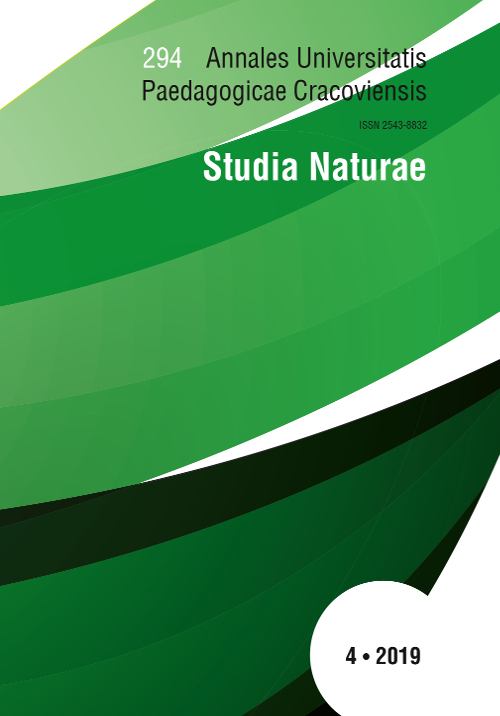Assessment of earthworms activity based on eaten biomass from selected catch crops
DOI:
https://doi.org/10.24917/25438832.4.4Keywords:
agroecosystem, Lumbricidae, cover cropsAbstract
The trophic activity of soil mesofauna, especially earthworms (the Lumbricidae family), is a key element in increasing the fertility of agroecosystems. Thee food strategies that earthworms use as part of the trophic networks in soil, and especially their food preferences, are still unknown. Much is known about what is the food substrate of earthworms, but the food preferences of individual species, as well as the possibilities and dynamics of food processing are not fully understood. The aim of the experiment was to observe the amount and dynamics of food uptake by the earthworms of the species Lumbricus terrestris L., which is a common species of soil Oligochaeta in agricultural areas, as well as to propose a new decomposition rate measuring the strength of the earthworm population and its contribution to the mechanism of processing plant organic matter.
Downloads
Metrics
References
Bilalis, D., Sidiras, N., Vavoulidou, E., Konstantas, A. (2009). Earthworm populations as affected by crop practices on clay loam soil in a Mediterranean climate. Acta Agriculturae Scandinavica Section B – Soil and Plant Science, 59(5), 440–446. https://doi.org/10.1080/09064710802342327
Bogdanowicz, W., Chudzicka, E., Pilipiuk, I., Skibińska, E. (2004). Fauna Polski. Charakterystyka i wykaz gatunków. Tom 1. Annelida. Warszawa: Wydawnictwo Instytutu i Muzeum Zoologii PAN, p. 1–11.[In Polish]
Bohlen, P.J., Parmelee, R.W., McCartney, D.A., Ewards, C.A. (1997). Earthworm effects on carbon and nitrogen dynamics of surface litter in corn agroecosystems. Ecological Application, 7, 1341–1349.Bouché, M.B. (1972). Lombriciens de France. Paris: Ecologie et Syste´matique, Institut National de la Recherche Agronomique. [In French]
Briones, M.J.I., Ostle, N.J., Piearce, T.G. (2008). Stable isotopes reveal that the calciferous gland of earthworms is a CO2-fixing organ. Soil Biology & Biochemistry, 40, 554–557. https://doi.org/10.1016/j.soilbio.2007.09.012
Briones, M.J.I., Schmidt, O. (2017). Conventional tillage decreases the abundance and biomass of earthworms and alters their community structure in a global meta-analysis. Global Change Biology, 23, 4396–4419. https://doi.org/10.1111/gcb.13744
Clause, J., Forey, E., Eisenhauer, N., Seal, C.E., Soudey, A., Colville, L., Barot, S. (2017). Seed selection by earthworms: chemical seed properties matter more than morphological traits. Plant Soil, 413, 97–110. https://doi.org/10.1007/s11104-016-3085-9
Curry, J.P., Schmidt, O. (2007). The feeding ecology of earthworms. Pedobiologia, 50, 463–477. https://doi.org/10.1016/j.pedobi.2006.09.001
Jodaugiene, D., Pupaliene, R., Sinkeviciene, A., Marcinkevisciene, A., Zebrauskaite, K., Baltaduonyte, M., Cepuliene, R. (2010). The influence of organic mulches on soil biological properties. Zemdirbyste, 97(2), 33–40.
Kostecka, J. (1999). Wpływ wybranych insektycydów na dżdżownice. Zeszyty Problemowe Postępów Nauk Rolniczych, 467, 603–607.[In Polish]
Li, K., Li, P. Li, H. (2010). Earthworms helping economy, improving ecology and protecting health. International Journal of Global Environmental Issues, 10(3), 354–365. https://doi.org/10.1504/IJGENVI.2010.037276
Liebeke, M., Strittmatter, N., Fearn, S., Morgan, A.J., Kille, P., Fuchser, J., Wallis, D., Palchykov, V., Robertson, J., Lahive, E., Spurgeon, DJ., McPhail, D., Takáts, Z., Bundy, J.G. (2015). Unique metabolites protect earthworms against plant polyphenols. Nature Communications, 6, 7869. https://doi.org/10.1038/ncomms8869
Majchrzak, B., Waleryś, Z., Ciska, E. (2005). Phytosanitary value of cruciferous plants as pre-crops of cereals I. Glucosinolate content in stems and roots of mature plants of Brassicaceae family. Oilseed Crops, 26, 199–209.[In Polish]
Munro, T.L., Cook, H.F., Lee, H.C. (2002). Sustainability indicators used to compare properties of organic and conventionally managed topsoils. Biological Agriculture & Horticulture, 20(3), 201–214. https://doi.org/10.1080/01448765.2002.9754965
Pelosi, C., Barot, S., Capowiez, Y., Hedde, M., Vandenbulcke, F. (2014). Pesticides and earthworms. A review. Agronomy for Sustainable Development, 34, 199–228. https://doi.org/10.1007/s13593-013-0151-z
Rouse, G.W. (2016). Phylum Annelida: the segmented (and some unsegmented) worms. In: R.C. Brusca, W. Moore, S. Schuster (eds.), Invertebrates, Third Edition. Sunderland: Sinauer Associates, p. 540– 569.
Sawicka, B., Kotiuk, E. (2007). Gorczyce jako rośliny wielofunkcyjne. Acta Scientiarum Polonorum seria Agricultura, 6(2), 17–27. [In Polish]
Wu, Y., Shaaban, M., Peng, Q., Zhou, A., Hu, R. (2018). Impacts of earthworm activity on the fate of straw carbon in soil: a microcosm experiment. Environmental Science and Pollution Research, 25, 11054–11062. https://doi.org/10.1007/s11356-018-1397-4

